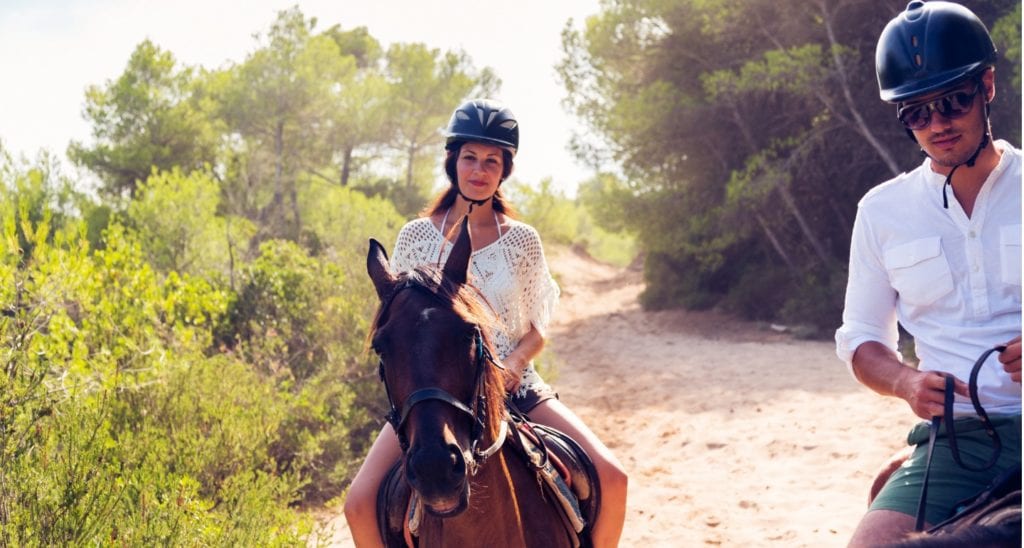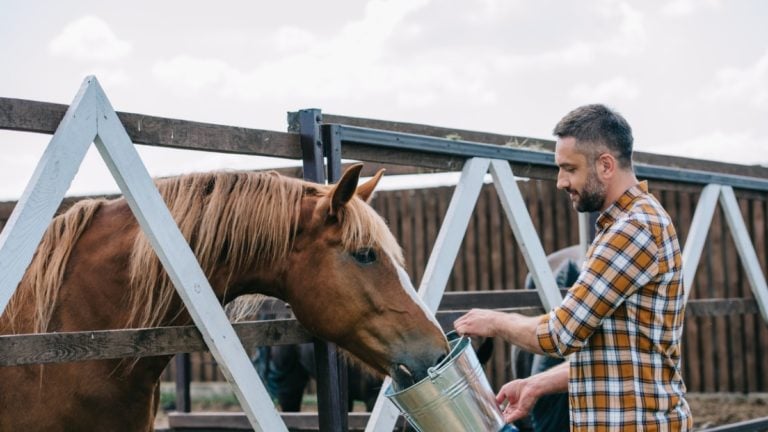Trail riding is one of the most fun activities you can do with your horse. It can be a relaxing break from schooling in the arena, whether you go for a short jaunt through the woods nearby or out to the mountains for an overnight equestrian adventure.
Preparation is key to enjoying an hour, a day or a weekend on the trail. For starters, you and your horse need to be physically and mentally fit for the task. You’ll also need to pack the appropriate gear for the length of your ride.
“Even if you’re only headed out for a couple of hours, you’ll want to bring some provisions,” says Audrey Pavia, director of region 2 of the North American Trail Ride Conference (NATRC) and author of “Trail Riding: A Complete Guide." “The amount you bring will depend on how long you plan to ride and the weather conditions.”
For Short Trail Riding Jaunts
1Food and Water
Water is a must, especially on hot days.
“On hot days, you’ll need to consume more water to keep from getting dehydrated,” says Pavia, who's also written "Horses for Dummies." “Consider freezing one or more bottles of water that you’ll be bringing along. By the time you are ready to drink them, they will have melted.
If you’ll be out all day, Pavia recommends packaging a lunch.
“A saddle pack with an insulated compartment can keep it cool,” she says.
If your trail ride is only a few hours long, she recommends bringing “some snacks, like nuts or a granola bar, to help keep your energy up.”
On all-day rides, be sure to keep your horse fed and hydrated, too.
“If you’ll be spending time at your trailer, hang a hay net and let your horse eat whenever he’s tied there,” Pavia says. “It will be hard to bring hay along on your ride, so you can allow your horse to graze when you take breaks.”
As for water breaks, Pavia recommends finding out if there will be natural water available along the trail or at the trailhead. If not, bring your own water to offer to your horse before you head out trail riding and when you return.
2Sunscreen
Even if you think you’ll be under the cover of trees or an overcast sky, you’ll be glad you used skin protection at the end of the day (and the years to come).
“Being out in the elements on a trail ride can be tough on your skin,” Pavia says. “Wear sunblock and have [lip balm with SPF] handy so you can reapply when necessary.”
Consult with your equine vet to see if your horse needs sunscreen. Pink spots found on the nose or around the eyes may be particularly sensitive to the sun. Equus Magnificus’ Essential Equine SPF 20 sunscreen is veterinary formulated to protect the nose, face and ears. Some horse sunscreens are sprayable, like Healthy HairCare’s Sunflower Suncoat sunscreen, which can be sprayed onto the horse’s coat, mane and tail to prevent sunburn and bleaching.
3Fly Protection
Apply bug repellent to your skin and clothes before heading out, and make sure your horse is protected, too. Choose a fly spray, such as Pyranha fly protection horse spray, that is formulated to repel a variety of flies, mosquitoes and other biting insects. You’re likely to encounter several different pests along the trail.
If rain is in the forecast or you might be traveling through wet areas, make sure to pack a waterproof bug spray, such as Farnam Endure horse roll-on fly repellent.
4Mobile Phone with Mapping App
Trail riding is a great time to unplug, but that doesn’t mean you should leave your cell phone at home.
“For your safety, always carry a fully charged cell phone when you trail ride,” Pavia recommends. “Keep the phone attached to your body, not to the saddle. If you become separated from your horse, you want to have your phone with you.”
It’s good to have a trail map with you, too. If there isn’t one available, use a tracking app on your phone to trace your path so you can double back if you get lost.
5Hoof Pick
This staple of your at-home grooming kit is essential on even a short trail ride.
“Always carry a hoof pick when you trail ride,” Pavia says. “You’ll need it if your horse picks up a stone in his hoof along the way.”
For one hoof pick option, consider the Wahl Horse hoof pick, which is designed with a strong, steel hook to help clean the sole thoroughly.
For Multi-Day Trail Riding
In addition to the products above, you’ll need a few more items for multi-day rides.
If you’re camping out with your horse, you’ll obviously need to bring along more food and water, for both you and your horse, than you would for a day trip.
“Some parks won’t allow loose forage because of the risk of non-native grass seeds being spread, so you may need to bring hay cubes or pellets instead,” Pavia says. “Make sure the cubes or pellets are the same kind of hay that you usually feed. You don’t want to switch your horse abruptly to a new diet.”
Pack along some water from home, too, in case there isn’t water available at your campsite. This also can be useful if your horse is fussy about the taste or smell of unfamiliar water. Pavia advises bringing at least 5 gallons of water per horse per day.
“Many horse trailers have room for a plastic water tank that can be strapped to the interior of the dressing room or the roof,” she says. “These tanks typically hold about 50 gallons of water. Another option is to fill a 5-gallon jug with water from home and transport it in your truck bed.”
For yourself and any other riders, be sure to plan your meals ahead of time.
“Quick, easy camping meals are baked beans and hot dogs or hamburgers,” Pavia suggests. “These can be great if you’ve got a fire pit with a grill or have a portable stove. Some people like to make gourmet meals when they are camping, and there are websites with recipes for these kinds of meals. Whatever you do, don’t forget the s’mores!”
Aside from more food and water, you’ll also need:
6A Sheet or Light Blanket
The temperature can drop considerably at night, so it’s a good idea to pack a sheet for your horse when camping.
“If your horse will be tied to a horse trailer overnight, he should wear a light blanket during the night,” Pavia says. “This will keep him from catching a chill after a long ride or when he can’t move around to stay warm.”
Jennifer Rice, DVM, Chewy’s resident equine vet, recommends Horseware Ireland’s Mio Lightweight Turnout Sheet and Horze Equestrian’s Nevada Lightweight Turnout Sheet, both of which are breathable, waterproof and windproof.
7Grooming Tools
8A Comfortable Overnight Halter
Pack a halter that will be comfortable for your horse to wear overnight and while tied. Dr. Rice recommends a breakaway halter for extended usage; that way if it catches on something in the middle of the night, it would break and your horse wouldn’t be injured. Weaver Leather’s Adjustable Breakaway Horse Halter is a good option here.
A spare halter and lead rope are always a good idea in case your horse damages one.
9Basic First-Aid Materials
10A Way to Carry it All
“You can buy nice accessories for your saddle that can help you carry all these items along on your trail ride,” Pavia says. “Water bottle holders [designed to] clip to the D-rings near the front of your saddle are a convenient way to carry water.
“Pommel bags work well for western saddles, making it easy to reach the items you’re carrying with you,” she adds. “For English saddles, cantle bags can be a good option for carrying whatever you want to bring along.”
Pommel bags, like this one from Weaver Leather, go over the horn of a western saddle, keeping your stored items right in front of you. Cantle bags for English saddles typically sit on the cantle and are attached by straps to the billets to keep your necessities right behind you. This cantle bag is made of durable polyester and provides generous storage for lead ropes, rain gear, cameras and more.
Good tack fit is important for any ride, but it's especially crucial for trail riding. Whether you ride English or western, your saddle and bridle need to fit your horse so he can move freely on varied terrain without chafing or pressure points. Keep your girth and saddle pad clean, as dirt and dried sweat against your horse's skin can cause sores.
Remember that your saddle needs to fit you, too, so you can ride comfortably and effectively. Consider a seat saver for added cushioning for especially long rides.
Leslie Potter is the web editor for Horse Illustrated magazine. She has a B.S. in Equestrian Science from William Woods University and has been a horse owner—and boarder—for more than 15 years.
BeChewy Executive Editor Stephanie Brown contributed to this article.
Get more expert advice on horse supplies:
Share:









